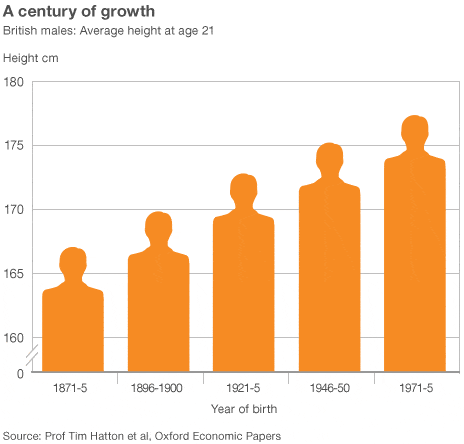A new study that surveyed through records of hundreds of thousands of men from 15 European countries found that the average height has risen by 11 centimeters since then 1870s. This remarkable surge in men’s height over the span of just four generations has been attributed to the advances in health care since, most notably antibiotics and a massive drop in infant mortality. Improved nutrition is factor that also played a determining role, according to the researchers involved in the study.
“Increases in human stature are a key indicator of improvements in the average health of populations,” said Timothy Hatton, a professor economics at Britain’s University of Essex who led the study.
Only men were surveyed since data on women were more limited. In the XIXth century and early XXth century, public records of men’s health and physical characteristics were far more abundant than those of women because of military service.
On average, men’s height had grown by 11 centimetres (cm) – from 167 cm to 178 cm – in just over a century, the researchers found, but there were differences from country to country. Most surprising was that during the two great wars, as well as the following Great Depression, there was a significant surge in average height for a select couple of countries like including Britain and Ireland, the Scandinavian countries, Netherlands, Austria, Belgium and Germany – times of notoriously great turmoil.
This was most surprising to learn because major advances in both medical science and medical reforms came after this period. Long-term improvements in sanitation, hygiene and nutrition were being seen at the time and this most likely is the cause of the upsurge, the researchers report. Reduced infant mortality, which is linked with basic child health in general, also means that children were healthier at the time, than they were before. The most important period that goes on to determine much of a human’s health later on in life are the first 2.5 years according to health experts. A downward trend in fertility during this period also played an important role, as fewer children per family meant there were more resources to spare, and thus an improved nutrition.
Dr John Middleton of the UK’s Faculty of Public Health said: “Does how tall we are really tell us how healthy we are? This interesting research suggests that it’s certainly a factor.
“Increasing height is a reflection of how the availability of food and nutrition had broadly improved until the recent excesses of fat and sugar.
“However, we can’t conclude that shorter men are somehow unhealthier. Like a lot of research, this paper prompts more questions than it set out to answer.
“While our average height is a useful barometer to bear in mind, what we really need is to tackle the many reasons for poor health that we can address.
“Employment is one of the best ways to do that, which is why we need to focus on more than just diet and exercise when it comes to improving the nation’s health.”
The findings were reported in the journal Oxford Economics Papers.
Was this helpful?




